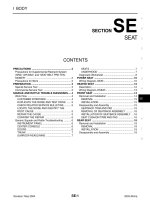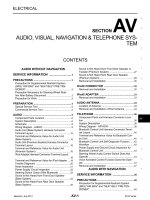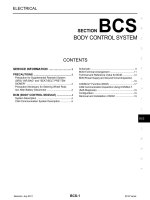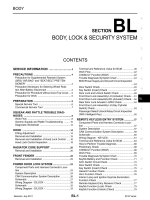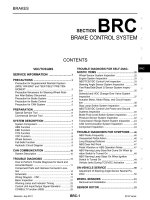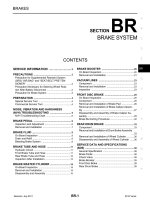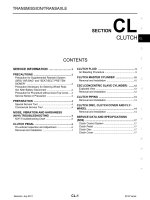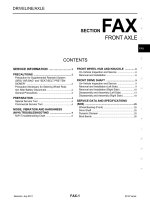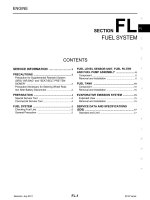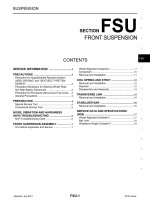HỆ THỐNG GHẾ NGỒI TRÊN NISSAN VERSA HATCH BACK ĐỜI 2012
Bạn đang xem bản rút gọn của tài liệu. Xem và tải ngay bản đầy đủ của tài liệu tại đây (1.76 MB, 26 trang )
SE-1
BODY
C
D
E
F
G
H
J
K
L
M
SECTION SE
A
B
SE
N
O
P
CONTENTS
SEAT
SERVICE INFORMATION 2
PRECAUTIONS 2
Precaution for Supplemental Restraint System
(SRS) "AIR BAG" and "SEAT BELT PRE-TEN-
SIONER"
2
Precaution Necessary for Steering Wheel Rota-
tion After Battery Disconnect
2
Service Notice 3
Precaution for Work 3
PREPARATION 4
Special Service Tool 4
Commercial Service Tool 4
SQUEAK AND RATTLE TROUBLE DIAG-
NOSES
5
Work Flow 5
Generic Squeak and Rattle Troubleshooting 7
Diagnostic Worksheet 9
FRONT SEAT 11
Exploded View 11
Removal and Installation 14
Disassembly and Assembly 14
REAR SEAT 21
Component Parts Drawing 21
Removal and Installation 22
Disassembly and Assembly 24
Revision: July 2011 2012 Versa
SE-2
< SERVICE INFORMATION >
PRECAUTIONS
SERVICE INFORMATION
PRECAUTIONS
Precaution for Supplemental Restraint System (SRS) "AIR BAG" and "SEAT BELT
PRE-TENSIONER"
INFOID:0000000007330237
The Supplemental Restraint System such as “AIR BAG” and “SEAT BELT PRE-TENSIONER”, used along
with a front seat belt, helps to reduce the risk or severity of injury to the driver and front passenger for certain
types of collision. This system includes seat belt switch inputs and dual stage front air bag modules. The SRS
system uses the seat belt switches to determine the front air bag deployment, and may only deploy one front
air bag, depending on the severity of a collision and whether the front occupants are belted or unbelted.
Information necessary to service the system safely is included in the SRS and SB section of this Service Man-
ual.
WARNING:
• To avoid rendering the SRS inoperative, which could increase the risk of personal injury or death in
the event of a collision which would result in air bag inflation, all maintenance must be performed by
an authorized NISSAN/INFINITI dealer.
• Improper maintenance, including incorrect removal and installation of the SRS can lead to personal
injury caused by unintentional activation of the system. For removal of Spiral Cable and Air Bag
Module, see the SRS section.
• Do not use electrical test equipment on any circuit related to the SRS unless instructed to in this
Service Manual. SRS wiring harnesses can be identified by yellow and/or orange harnesses or har-
ness connectors.
PRECAUTIONS WHEN USING POWER TOOLS (AIR OR ELECTRIC) AND HAMMERS
WARNING:
• When working near the Airbag Diagnosis Sensor Unit or other Airbag System sensors with the Igni-
tion ON or engine running, DO NOT use air or electric power tools or strike near the sensor(s) with a
hammer. Heavy vibration could activate the sensor(s) and deploy the air bag(s), possibly causing
serious injury.
• When using air or electric power tools or hammers, always switch the Ignition OFF, disconnect the
battery, and wait at least 3 minutes before performing any service.
Precaution Necessary for Steering Wheel Rotation After Battery Disconnect
INFOID:0000000007330238
NOTE:
• This Procedure is applied only to models with Intelligent Key system and NATS (NISSAN ANTI-THEFT SYS-
TEM).
• Remove and install all control units after disconnecting both battery cables with the ignition knob in the
″LOCK″ position.
• Always use CONSULT to perform self-diagnosis as a part of each function inspection after finishing work. If
DTC is detected, perform trouble diagnosis according to self-diagnostic results.
For models equipped with the Intelligent Key system and NATS, an electrically controlled steering lock mech-
anism is adopted on the key cylinder.
For this reason, if the battery is disconnected or if the battery is discharged, the steering wheel will lock and
steering wheel rotation will become impossible.
If steering wheel rotation is required when battery power is interrupted, follow the procedure below before
starting the repair operation.
OPERATION PROCEDURE
1. Connect both battery cables.
NOTE:
Supply power using jumper cables if battery is discharged.
2. Use the Intelligent Key or mechanical key to turn the ignition switch to the ″ACC″ position. At this time, the
steering lock will be released.
3. Disconnect both battery cables. The steering lock will remain released and the steering wheel can be
rotated.
4. Perform the necessary repair operation.
Revision: July 2011 2012 Versa
PRECAUTIONS
SE-3
< SERVICE INFORMATION >
C
D
E
F
G
H
J
K
L
M
A
B
SE
N
O
P
5. When the repair work is completed, return the ignition switch to the ″LOCK″ position before connecting
the battery cables. (At this time, the steering lock mechanism will engage.)
6. Perform a self-diagnosis check of all control units using CONSULT.
Service Notice INFOID:0000000007330239
• When removing or installing various parts, place a cloth or padding onto the vehicle body to prevent
scratches.
• Handle trim, molding instruments, grille, etc. carefully during removing or installing. Be careful not to oil or
damage them.
• Apply sealing compound where necessary when installing parts.
• When applying sealing compound, be careful that the sealing compound does not protrude from parts.
• When replacing any metal parts (for example body outer panel, member, etc.), be sure to take rust preven-
tion measures.
Precaution for Work INFOID:0000000007793387
• When removing or disassembling each component, be careful not to damage or deform it. If a component
may be subject to interference, be sure to protect it with a shop cloth.
• When removing (disengaging) components with a screwdriver or similar tool, be sure to wrap the component
with a shop cloth or vinyl tape to protect it.
• Protect the removed parts with a shop cloth and prevent them from being dropped.
• Replace a deformed or damaged clip.
• If a part is specified as a non-reusable part, always replace it with new one.
• Be sure to tighten bolts and nuts securely to the specified torque.
• After installation is complete, be sure to check that each part works properly.
• Follow the steps below to clean components.
- Water soluble dirt: Dip a soft cloth into lukewarm water, and wring the water out of the cloth to wipe the dirty
area.
Then rub with a soft and dry cloth.
- Oily dirt: Dip a soft cloth into lukewarm water with mild detergent (concentration: within 2 to 3%), and wipe
the dirty area.
Then dip a cloth into fresh water, and wring the water out of the cloth to wipe the detergent off. Then rub with
a soft and dry cloth.
• Do not use organic solvent such as thinner, benzene, alcohol, or gasoline.
• For genuine leather seats, use a genuine leather seat cleaner.
Revision: July 2011 2012 Versa
SE-4
< SERVICE INFORMATION >
PREPARATION
PREPARATION
Special Service Tool INFOID:0000000007330241
The actual shapes of Kent-Moore tools may differ from those of special service tools illustrated here.
Commercial Service Tool INFOID:0000000007330242
Tool number
(Kent-Moore No.)
Tool name
Description
—
(J-39570)
Chassis ear
Locating the noise
—
(J-43980)
NISSAN Squeak and Rattle
Kit
Repairing the cause of noise
—
(J-46534)
Trim Tool Set
Removing trim components
SIIA0993E
SIIA0994E
AWJIA0483ZZ
(Kent-Moore No.)
Tool name
Description
(J-39565)
Engine ear
Locating the noise
SIIA0995E
Revision: July 2011 2012 Versa
SQUEAK AND RATTLE TROUBLE DIAGNOSES
SE-5
< SERVICE INFORMATION >
C
D
E
F
G
H
J
K
L
M
A
B
SE
N
O
P
SQUEAK AND RATTLE TROUBLE DIAGNOSES
Work Flow INFOID:0000000007330243
CUSTOMER INTERVIEW
Interview the customer if possible, to determine the conditions that exist when the noise occurs. Use the Diag-
nostic Worksheet during the interview to document the facts and conditions when the noise occurs and any
customer's comments; refer to SE-9, "
Diagnostic Worksheet". This information is necessary to duplicate the
conditions that exist when the noise occurs.
• The customer may not be able to provide a detailed description or the location of the noise. Attempt to obtain
all the facts and conditions that exist when the noise occurs (or does not occur).
• If there is more than one noise in the vehicle, be sure to diagnose and repair the noise that the customer is
concerned about. This can be accomplished by test driving the vehicle with the customer.
• After identifying the type of noise, isolate the noise in terms of its characteristics. The noise characteristics
are provided so the customer, service adviser and technician are all speaking the same language when
defining the noise.
• Squeak —(Like tennis shoes on a clean floor)
Squeak characteristics include the light contact/fast movement/brought on by road conditions/hard surfaces
= higher pitch noise/softer surfaces = lower pitch noises/edge to surface = chirping.
• Creak—(Like walking on an old wooden floor)
Creak characteristics include firm contact/slow movement/twisting with a rotational movement/pitch depen-
dent on materials/often brought on by activity.
• Rattle—(Like shaking a baby rattle)
Rattle characteristics include the fast repeated contact/vibration or similar movement/loose parts/missing
clip or fastener/incorrect clearance.
• Knock —(Like a knock on a door)
Knock characteristics include hollow sounding/sometimes repeating/often brought on by driver action.
• Tick—(Like a clock second hand)
Tick characteristics include gentle contacting of light materials/loose components/can be caused by driver
action or road conditions.
• Thump—(Heavy, muffled knock noise)
Thump characteristics include softer knock/dead sound often brought on by activity.
• Buzz—(Like a bumble bee)
Buzz characteristics include high frequency rattle/firm contact.
• Often the degree of acceptable noise level will vary depending upon the person. A noise that you may judge
as acceptable may be very irritating to the customer.
• Weather conditions, especially humidity and temperature, may have a great effect on noise level.
DUPLICATE THE NOISE AND TEST DRIVE
If possible, drive the vehicle with the customer until the noise is duplicated. Note any additional information on
the Diagnostic Worksheet regarding the conditions or location of the noise. This information can be used to
duplicate the same conditions when you confirm the repair.
SBT842
Revision: July 2011 2012 Versa
SE-6
< SERVICE INFORMATION >
SQUEAK AND RATTLE TROUBLE DIAGNOSES
If the noise can be duplicated easily during the test drive, to help identify the source of the noise, try to dupli-
cate the noise with the vehicle stopped by doing one or all of the following:
1) Close a door.
2) Tap or push/pull around the area where the noise appears to be coming from.
3) Rev the engine.
4) Use a floor jack to recreate vehicle “twist”.
5) At idle, apply engine load (electrical load, half-clutch on M/T model, shift selector in the drive position for
CVT and A/T models).
6) Raise the vehicle on a hoist and hit a tire with a rubber hammer.
• Drive the vehicle and attempt to duplicate the conditions the customer states exist when the noise occurs.
• If it is difficult to duplicate the noise, drive the vehicle slowly on an undulating or rough road to stress the
vehicle body.
CHECK RELATED SERVICE BULLETINS
After verifying the customer concern or symptom, check ASIST for Technical Service Bulletins (TSBs) related
to that concern or symptom.
If a TSB relates to the symptom, follow the procedure to repair the noise.
LOCATE THE NOISE AND IDENTIFY THE ROOT CAUSE
1. Narrow down the noise to a general area.To help pinpoint the source of the noise, use a listening tool
(Chassis Ear: J-39570, Engine Ear: J-39565 and mechanic's stethoscope).
2. Narrow down the noise to a more specific area and identify the cause of the noise by:
• removing the components in the area that you suspect the noise is coming from.
Do not use too much force when removing clips and fasteners, otherwise clips and fasteners can be broken
or lost during the repair, resulting in the creation of new noise.
• tapping or pushing/pulling the component that you suspect is causing the noise.
Do not tap or push/pull the component with excessive force, otherwise the noise will be eliminated only tem-
porarily.
• feeling for a vibration with your hand by touching the component(s) that you suspect is (are) causing the
noise.
• placing a piece of paper between components that you suspect are causing the noise.
• looking for loose components and contact marks.
Refer to SE-7, "
Generic Squeak and Rattle Troubleshooting".
REPAIR THE CAUSE
• If the cause is a loose component, tighten the component securely.
• If the cause is insufficient clearance between components:
- separate components by repositioning or loosening and retightening the component, if possible.
- insulate components with a suitable insulator such as urethane pads, foam blocks, felt cloth tape or urethane
tape. A NISSAN Squeak and Rattle Kit (J-43980) is available through your authorized NISSAN Parts Depart-
ment.
CAUTION:
Do not use excessive force as many components are constructed of plastic and may be damaged.
Always check with the Parts Department for the latest parts information.
The following materials are contained in the NISSAN Squeak and Rattle Kit (J-43980). Each item can be
ordered separately as needed.
URETHANE PADS [1.5 mm (0.059 in) thick]
Insulates connectors, harness, etc.
76268-9E005: 100×135 mm (3.94×5.31 in)/76884-71L01: 60×85 mm (2.36×3.35 in)/76884-71L02: 15×25
mm (0.59×0.98 in)
INSULATOR (Foam blocks)
Insulates components from contact. Can be used to fill space behind a panel.
73982-9E000: 45 mm (1.77 in) thick, 50×50 mm (1.97×1.97 in)/73982-50Y00: 10 mm (0.39 in) thick,
50×50 mm (1.97×1.97 in)
INSULATOR (Light foam block)
80845-71L00: 30 mm (1.18 in) thick, 30×50 mm (1.18×1.97 in)
FELT CLOTH TAPE
Used to insulate where movement does not occur. Ideal for instrument panel applications.
68370-4B000: 15×25 mm (0.59×0.98 in) pad/68239-13E00: 5 mm (0.20 in) wide tape roll. The following
materials not found in the kit can also be used to repair squeaks and rattles.
UHMW (TEFLON) TAPE
Revision: July 2011 2012 Versa
SQUEAK AND RATTLE TROUBLE DIAGNOSES
SE-7
< SERVICE INFORMATION >
C
D
E
F
G
H
J
K
L
M
A
B
SE
N
O
P
Insulates where slight movement is present. Ideal for instrument panel applications.
SILICONE GREASE
Used instead of UHMW tape that will be visible or not fit.
Note: Will only last a few months.
SILICONE SPRAY
Use when grease cannot be applied.
DUCT TAPE
Use to eliminate movement.
CONFIRM THE REPAIR
Confirm that the cause of a noise is repaired by test driving the vehicle. Operate the vehicle under the same
conditions as when the noise originally occurred. Refer to the notes on the Diagnostic Worksheet.
Generic Squeak and Rattle Troubleshooting INFOID:0000000007330244
Refer to Table of Contents for specific component removal and installation information.
INSTRUMENT PANEL
Most incidents are caused by contact and movement between:
1. The cluster lid A and instrument panel
2. Acrylic lens and combination meter housing
3. Instrument panel to front pillar garnish
4. Instrument panel to windshield
5. Instrument panel mounting pins
6. Wiring harnesses behind the combination meter
7. A/C defroster duct and duct joint
These incidents can usually be located by tapping or moving the components to duplicate the noise or by
pressing on the components while driving to stop the noise. Most of these incidents can be repaired by apply-
ing felt cloth tape or silicone spray (in hard to reach areas). Urethane pads can be used to insulate wiring har-
ness.
CAUTION:
Do not use silicone spray to isolate a squeak or rattle. If you saturate the area with silicone, you will
not be able to recheck the repair.
CENTER CONSOLE
Components to pay attention to include:
1. Shift selector cover to finisher
2. A/C control unit and cluster lid C
3. Wiring harnesses behind audio and A/C control unit
The instrument panel repair and isolation procedures also apply to the center console.
DOORS
Pay attention to the:
1. Finisher and inner panel making a slapping noise
2. Inside handle escutcheon to door finisher
3. Wiring harnesses tapping
4. Door striker out of alignment causing a popping noise on starts and stops
Tapping or moving the components or pressing on them while driving to duplicate the conditions can isolate
many of these incidents. You can usually insulate the areas with felt cloth tape or insulator foam blocks from
the NISSAN Squeak and Rattle Kit (J-43980) to repair the noise.
TRUNK
Trunk noises are often caused by a loose jack or loose items put into the trunk by the owner.
In addition look for:
1. Trunk lid bumpers out of adjustment
2. Trunk lid striker out of adjustment
3. The trunk lid torsion bars knocking together
4. A loose license plate or bracket
Revision: July 2011 2012 Versa
SE-8
< SERVICE INFORMATION >
SQUEAK AND RATTLE TROUBLE DIAGNOSES
Most of these incidents can be repaired by adjusting, securing or insulating the item(s) or component(s) caus-
ing the noise.
SUNROOF/HEADLINING
Noises in the sunroof/headlining area can often be traced to one of the following:
1. Sunroof lid, rail, linkage or seals making a rattle or light knocking noise
2. Sun visor shaft shaking in the holder
3. Front or rear windshield touching headliner and squeaking
Again, pressing on the components to stop the noise while duplicating the conditions can isolate most of these
incidents. Repairs usually consist of insulating with felt cloth tape.
OVERHEAD CONSOLE (FRONT AND REAR)
Overhead console noises are often caused by the console panel clips not being engaged correctly. Most of
these incidents are repaired by pushing up on the console at the clip locations until the clips engage.
In addition look for:
1. Loose harness or harness connectors.
2. Front console map/reading lamp lense loose.
3. Loose screws at console attachment points.
SEATS
When isolating seat noise it's important to note the position the seat is in and the load placed on the seat when
the noise is present. These conditions should be duplicated when verifying and isolating the cause of the
noise.
Cause of seat noise include:
1. Headrest rods and holder
2. A squeak between the seat pad cushion and frame
3. The rear seatback lock and bracket
These noises can be isolated by moving or pressing on the suspected components while duplicating the con-
ditions under which the noise occurs. Most of these incidents can be repaired by repositioning the component
or applying urethane tape to the contact area.
UNDERHOOD
Some interior noise may be caused by components under the hood or on the engine wall. The noise is then
transmitted into the passenger compartment.
Causes of transmitted underhood noise include:
1. Any component mounted to the engine wall
2. Components that pass through the engine wall
3. Engine wall mounts and connectors
4. Loose radiator mounting pins
5. Hood bumpers out of adjustment
6. Hood striker out of adjustment
These noises can be difficult to isolate since they cannot be reached from the interior of the vehicle. The best
method is to secure, move or insulate one component at a time and test drive the vehicle. Also, engine RPM
or load can be changed to isolate the noise. Repairs can usually be made by moving, adjusting, securing, or
insulating the component causing the noise.
Revision: July 2011 2012 Versa
SQUEAK AND RATTLE TROUBLE DIAGNOSES
SE-9
< SERVICE INFORMATION >
C
D
E
F
G
H
J
K
L
M
A
B
SE
N
O
P
Diagnostic Worksheet INFOID:0000000007330245
LAIA0072E
Revision: July 2011 2012 Versa
SE-10
< SERVICE INFORMATION >
SQUEAK AND RATTLE TROUBLE DIAGNOSES
LAIA0071E
Revision: July 2011 2012 Versa
FRONT SEAT
SE-11
< SERVICE INFORMATION >
C
D
E
F
G
H
J
K
L
M
A
B
SE
N
O
P
FRONT SEAT
Exploded View INFOID:0000000007330246
DRIVER SEAT
AWJIA0745GB
Revision: July 2011 2012 Versa
SE-12
< SERVICE INFORMATION >
FRONT SEAT
PASSENGER SEAT
1. Seatback trim 2. Seatback pad 3. Seat belt buckle
4. Reclining lever 5. Reclining lever cover 6. Lifter lever cover (if equipped)
7. Lifter lever screws (if equipped) 8. Lifter lever (if equipped) 9. Reclining lever clip
10. Seat cushion inner finisher 11. Seat cushion inner finisher lower (if
equipped)
12. Slide inner cover (if equipped)
13. Reclining device inner cover 14. Seat cushion trim 15. Seat cushion pad
16. Front leg cover 17. Seat cushion outer finisher lower (if
equipped)
18. Seat cushion outer finisher
19. Side air bag module 20. Rear leg cover 21. Chute rod
22. Seat assembly 23. Headrest holder (locked) 24. Headrest holder (free)
25. Headrest
Revision: July 2011 2012 Versa
FRONT SEAT
SE-13
< SERVICE INFORMATION >
C
D
E
F
G
H
J
K
L
M
A
B
SE
N
O
P
1. Headrest 2. Headrest holder (locked) 3. Headrest holder (free)
4. Seat assembly 5. Chute rod 6. Rear leg cover
7. Side air bag module 8. Seat cushion outer finisher 9. Front leg cover
10. Seat cushion inner finisher 11. Reclining lever clip 12. Reclining lever
13. Reclining lever cover 14. Seat belt buckle 15. Seatback pad
16. Seatback trim
AWJIA0746GB
Revision: July 2011 2012 Versa
SE-14
< SERVICE INFORMATION >
FRONT SEAT
Removal and Installation
INFOID:0000000007330248
CAUTION:
• When removing and installing, use shop cloths to protect parts from damage.
• Before removal, be sure to turn ignition switch OFF, disconnect both battery terminals, then wait for
at least three minutes.
REMOVAL
1. Disconnect the negative and positive battery terminals, then wait at least three minutes.
2. Remove the seat assembly bolts on the back side of the front seat.
3. Remove the seat assembly bolts on the front side of the front seat.
4. Disconnect the body harness connector(s), then release the harness clips from the seat assembly.
5. Remove the front seat assembly from the vehicle.
NOTE:
Before removing the seat assembly from the vehicle, adjust the seatback to the upright position.
INSTALLATION
Installation is in the reverse order of removal.
CAUTION:
Always route the side air bag module harness in the original location. Replace any deformed or dam-
aged clips with the same type and color. Always install clips in the original location on the harness.
NOTE:
• Before installation of the seat assembly, confirm that the inside and outside slide rails are both locked at the
same positions.
• Confirm that the slide rail locating pin is set to the locating hole on the floor.
Disassembly and Assembly INFOID:0000000007330249
SEAT CUSHION FINISHER
CAUTION:
• Front passenger seat is equipped with an Occupant Classification System sensor and control mod-
ule. Do not disassemble front passenger seat cushion assembly or remove the seat cushion trim as
this will affect the Occupant Classification System calibration.
• During installation, the harness clips must be installed in the holes they were originally in. Do not
add additional clips.
Disassembly
1. Remove the front seat assembly. Refer to SE-14, "Removal and Installation".
2. Remove the reclining lever.
a. Remove the reclining lever cover.
b. Release the reclining lever clip and remove the reclining lever.
3. Remove the lifter lever (if equipped).
a. Remove the lifter lever cover.
b. Remove the lifter lever screws.
c. Remove the lifter lever.
4. Remove the front seat belt buckle. Refer to SB-4, "
Removal and Installation of Front Seat Belt".
5. Remove the screws, then remove the seat cushion inner finisher
lower (if equipped).
PIIB2607E
Revision: July 2011 2012 Versa
FRONT SEAT
SE-15
< SERVICE INFORMATION >
C
D
E
F
G
H
J
K
L
M
A
B
SE
N
O
P
6. Release the clips, then remove the seat cushion outer finisher.
7. For driver seat, remove the seat cushion outer finisher lower (if equipped).
a. Release the clip at the back inside edge of the seat cushion outer finisher lower.
b. Release the metal clips and remove the seat cushion outer finisher lower.
Assembly
Assembly is in the reverse order of disassembly.
SEAT CUSHION TRIM AND PAD
Disassembly
CAUTION:
• Front passenger seat is equipped with an Occupant Classification System sensor and control mod-
ule. Do not disassemble front passenger seat cushion assembly or remove the seat cushion trim as
this will affect the Occupant Classification System calibration.
• During installation, the harness clips must be installed in the holes they were originally in. Do not
add additional clips.
NOTE:
For passenger side only, the occupant classification system control unit, occupant classification system sen-
sor, and bladder are an integral part of the front passenger seat cushion trim and pad and are replaced
together as an assembly.
1. Remove the seat cushion finishers. Refer to "SEAT CUSHION FINISHER".
2. Remove the J-retainer of seat cushion trim.
3. Remove the hog rings to separate the seat cushion pad and seat cushion trim.
NOTE:
Remove all pieces of hog rings and discard them.
4. Remove seat cushion trim and seat cushion pad from the seat cushion frame.
Assembly
Assembly is in the reverse order of disassembly.
Install new hog rings on the seat cushion trim in their original positions.
NOTE:
Use NISSAN standard hog rings to assemble.
SEATBACK
WARNING:
Never leave any objects (screwdrivers, tools, etc.) on the seat during seatback repair. It can lead to
personal injury if the side air bag module should accidentally deploy.
CAUTION:
• Before servicing, turn ignition switch OFF, disconnect both battery terminals and wait at least 3 min-
utes.
• Handle the side air bag module carefully. During disassembly, always hold the side air bag module,
do not let it hang by the wire harness.
• Always place the side air bag module with the deployment side facing upward.
• Always work from the side or back of the seatback assembly, do not work in front of seat.
• Do not use air tools or electric tools for servicing the seat assembly.
• Replace the side air bag module if it has been dropped or sustained an impact.
: Metal clip : Clip
PIIB2609E
Revision: July 2011 2012 Versa
SE-16
< SERVICE INFORMATION >
FRONT SEAT
• Do not insert any objects into the side air bag module.
• Do not attempt to disassemble the side air bag module.
• Do not expose the side air bag module to temperatures exceeding 90°C (194°F).
• Do not expose the side air bag module to any oil, grease, detergent or water.
• During disassembly, do not damage the seatback trim, chutes, harness connectors, retainers, clips,
module harness or the side air bag module.
NOTE:
• If the vehicle has been involved in a collision and the side air bag has deployed, the front seatback assembly
must be replaced.
• Driver side shown, passenger side similar.
Disassembly
1. Remove the front seat assembly. Refer to SE-14, "Removal and Installation".
2. Release the seatback lower center J-retainer (A).
3. Release the seatback lower left and right J-retainers (B).
4. Unzip the slider (A) of the seatback outboard side zipper, then
unzip the slider of the seatback inboard side zipper (if
equipped).
ALJIA0702ZZ
ALJIA0710ZZ
Revision: July 2011 2012 Versa
FRONT SEAT
SE-17
< SERVICE INFORMATION >
C
D
E
F
G
H
J
K
L
M
A
B
SE
N
O
P
5. Remove and discard the two chute rod nuts (A). Then remove
the chute rod (1) by routing it through the loops in the outer
chute (B) and the inner chute (C).
: Front
CAUTION:
Do not reuse the chute rod nuts.
6. Press the headrest holder lock button in and remove the headrest.
7. Remove the headrest holders by pinching the hooks together at
the bottom and pulling them upward and out of the seatback.
CAUTION:
Make sure to note the position of headrest holders for
proper lock/free operation after assembly.
8. Push the bottom of the seatback trim and pad toward front edge of seat, away from the seatback frame,
then remove the seatback trim and pad by lifting them together as an assembly.
CAUTION:
Make sure to lift the seatback trim and pad from the seatback frame slowly, or it may get torn.
9. Release the side air bag module harness clips.
a. Release the side air bag module harness upper clip (A) from the
seatback frame lower crossbar.
: Front
ALJIA0703ZZ
PIIB4084J
ALJIA0704ZZ
Revision: July 2011 2012 Versa
SE-18
< SERVICE INFORMATION >
FRONT SEAT
b. For seats equipped with seat lifter, release the side air bag mod-
ule harness lower clips (A) from the seat cushion frame.
: Front
c. Release the side air bag module harness lower and front clips
(A) and harness connector clip (B) from the seat frame.
: Front
: Clip
10. Remove the side air bag module.
a. Route the side air bag module harness and harness clips through the slot in the seat cushion trim.
ALJIA0711ZZ
ALJIA0705ZZ
Revision: July 2011 2012 Versa
FRONT SEAT
SE-19
< SERVICE INFORMATION >
C
D
E
F
G
H
J
K
L
M
A
B
SE
N
O
P
b. Remove and discard the two side air bag module nuts (A).
CAUTION:
Do not reuse the side air bag module nuts.
c. Remove the side air bag module (1) from the seatback frame
(2).
11. If necessary, separate the seatback trim from the seatback pad by cutting the center of hog rings and
removing them.
NOTE:
Remove all pieces of hog rings and discard them.
Assembly
Assembly is in the reverse order of disassembly.
CAUTION:
• If a malfunction was detected by the air bag warning lamp, after repair or replacement of the mal-
function parts, reset the memory using self-diagnosis or CONSULT.
• After work is completed, check that no system malfunction is detected by air bag warning lamp.
• Always install new side air bag module nuts and side air bag chute rod nuts.
• Always route the side air bag module harness in the original location. Replace any deformed or dam-
aged clips with the same type and color. Always install clips in the original location on the harness.
• Smooth out all wrinkles in chutes and trim during assembly.
• Inspect seatback trim, seatback pad and side air bag chutes. Replace any damaged parts.
• Replace any deformed or damaged parts.
• Replace any deformed or damaged hog rings. Make sure any old hog ring pieces are removed from
seat.
• Use only one hog ring in each designated location.
• Make sure hog rings are correctly fastened around both the seatback trim and seatback pad wires.
NOTE:
Use NISSAN standard hog rings to assemble.
• Before installing headrest holders, check for their correct orientation. (Front/Rear, Right/Left)
• When installing the seatback trim, firmly press on the seams to make sure the hook and loop fasteners
below the trim are fastened properly.
ALJIA0706ZZ
Revision: July 2011 2012 Versa
SE-20
< SERVICE INFORMATION >
FRONT SEAT
• Install new hog rings on the seatback trim in their original positions.
• Make sure the chute rod (2) is properly positioned and installed
with the round hole opening (A) at the top and the oblong hole
opening (B) at the bottom as shown.
: Front
CAUTION:
Do not reuse chute rod nuts.
NOTE:
Make sure that both the side air bag inner chute end (C) and outer
chute end (D) are pushed through the opening in the seatback
pad.
• Make sure the side air bag outer chute (A) is pulled around the out-
board surface of the side air bag module (2) and the side air bag
inner chute (B) is pulled around the inboard surface of the side air
bag module and seatback frame (5). Make sure there are no wrin-
kles in the chute fabric, and the chutes are not folded, twisted or
pinched.
(1) Seatback pad
(3) Seatback trim
(4) Chute rod
: Front
PIIB3356J
ALJIA0707ZZ
ALJIA0708ZZ
Revision: July 2011 2012 Versa
REAR SEAT
SE-21
< SERVICE INFORMATION >
C
D
E
F
G
H
J
K
L
M
A
B
SE
N
O
P
REAR SEAT
Component Parts Drawing INFOID:0000000007330250
60:40 SPLIT FOLD DOWN SEAT - HATCHBACK
ALJIA0527ZZ
1. Rear seatback lock knob 2. Rear seat striker cover 3. Rear seatback side trim RH
4. Rear seatback side assembly RH 5.
Rear seatback side pad and frame
RH
6. Rear seatback trim RH
Revision: July 2011 2012 Versa
SE-22
< SERVICE INFORMATION >
REAR SEAT
Removal and Installation
INFOID:0000000007330251
CAUTION:
When removing and installing, use shop cloths to protect parts from damage.
60:40 SPLIT FOLD DOWN SEAT - HATCHBACK
Removal
1. Remove the tonneau board. Refer toEI-44, "Removal and Installation".
2. Remove the luggage floor center board. Refer to EI-44, "
Removal and Installation".
3. Pull seat cushion up, then remove the seat cushion from the
seat cushion hook.
NOTE:
• Always replace the seat cushion hooks when the seat cushion
has been released.
4. Remove the center seatbelt anchor bolt (A) from under the seat.
5. Remove the seatback bolts in the reverse order as shown from
the right rear seat back brackets.
7. Rear seatback assembly RH 8. Rear seatback pad RH 9. Seat cushion assembly
10. Rear seat cushion trim 11. Rear seat cushion pad and frame 12. Rear seat cushion hook (body)
13. Rear seatback assembly LH 14. Rear seatback trim LH 15. Rear seatback pad LH
16. Trim clip 17. Rear seatback side trim RH 18.
Rear seatback side pad and frame
LH
19. Rear seatback side assembly LH 20. Rear seat lock assembly 21. Locking headrest holder
22. Rear headrest 23. Free headrest holder 24. Rear seat cushion hook (seat)
25. Rear seatback side bracket 26. Rear seat striker RH 27. Rear seatback center bracket
28. Rear seat striker LH
PIIB4085J
WIIA1234E
WIIA1287E
Revision: July 2011 2012 Versa
REAR SEAT
SE-23
< SERVICE INFORMATION >
C
D
E
F
G
H
J
K
L
M
A
B
SE
N
O
P
6. Remove the seatback bolts in the reverse order as shown from
the left rear seat back brackets.
7. Remove the seatback from the vehicle.
8. Remove the kicking plate rear inner. Refer to EI-35, "
Component".
9. Remove the bolt under the seatback side.
10. Pull seatback side up, and then remove seatback side.
11. Remove the rear seatback center bracket bolts and the rear seatback center bracket.
12. Remove the rear seatback side bracket bolt and the rear seat-
back side bracket.
13. Remove the rear seatback finisher. Refer to SE-21, "
Component Parts Drawing".
14. Remove the rear seat striker bolts and the rear seat striker.
Installation
Installation is in the reverse order of removal.
• When installing the rear seatback side bracket perform the following procedure:
WIIA1288E
PIIB2482J
PIIB2483J
PIIB2484J
Revision: July 2011 2012 Versa
SE-24
< SERVICE INFORMATION >
REAR SEAT
1. Install the rear seatback side bracket, temporarily tighten the
seatback assembly and rear seatback side bracket bolt.
2. Lift to fold up seatback assembly. Be sure to lock seatback
assembly to rear seat striker.
3. Tighten the rear seatback side bracket bolt.
NOTE:
Confirm that side hinge bracket location pin is set to the hole on
the seatback backside.
• Install the left rear seat back brackets and seatback bolts.
• Install the right rear seat back brackets and the rear seat back
bracket bolts.
Disassembly and Assembly INFOID:0000000007330252
60:40 SPLIT FOLD DOWN SEAT - HATCHBACK
Disassembly of Armrest
1. Fold up the backside of the seatback trim and then remove the
armrest nuts.
PIIB2484J
WIIA1288E
WIIA1287E
PIIB2913J
Revision: July 2011 2012 Versa
REAR SEAT
SE-25
< SERVICE INFORMATION >
C
D
E
F
G
H
J
K
L
M
A
B
SE
N
O
P
2. Push the armrest toward left side while pulling backward to
remove.
3. Remove the rear seat bushing, and then remove the armrest
hinge cover by pulling it backward.
Assembly of Armrest
Assembly is in the reverse order of disassembly.
Disassembly of Seatback Trim and Pad
1. Remove the headrest.
2. Remove the retainer under the back of seatback.
3. Remove the clips, and then remove the striker cover.
PIIB2915J
PIIB6507E
PIIB2486J
PIIB2485J
Revision: July 2011 2012 Versa
